Abstract
Many newly defined tumour antigens are 'self' proteins. Immunizing cancer patients against these antigens may be difficult due to tolerance. The HER-2/neu oncogenic protein is such a 'self' tumour antigen. Rat neu is homologous with human HER-2/neu and provides a model system for studying vaccination strategies. Rats are tolerant to rat neu. Vaccination with this 'self' protein elicits no detectable immune response. The current studies evaluated whether tolerance to rat neu can be circumvented by immunizing with the highly homologous foreign human HER-2/neu protein. Rats were immunized with human HER-2/neu intracellular domain (hICD) protein that is 92% homologous to rat neu ICD. Animals immunized with hICD developed significant antibody and T-cell responses that were specific for both human HER-2/neu and rat neu. Neu-specific antibodies were present in titres of greater than 1:200,000. Analysis of the specificity of the antibody response using synthetic peptides demonstrated substantial reactivity to an epitope with 100% homology between rat and human protein. Significant T-cell responses (stimulation index > 10) to hICD and rat neu protein (stimulation index > 4) were detected. The T cells also responded to both human and rat ICD. The results imply that immunization with foreign proteins, which are highly homologous to 'self' tumour antigens, may be an effective vaccine strategy for 'self' tumour antigens.
Full text
PDF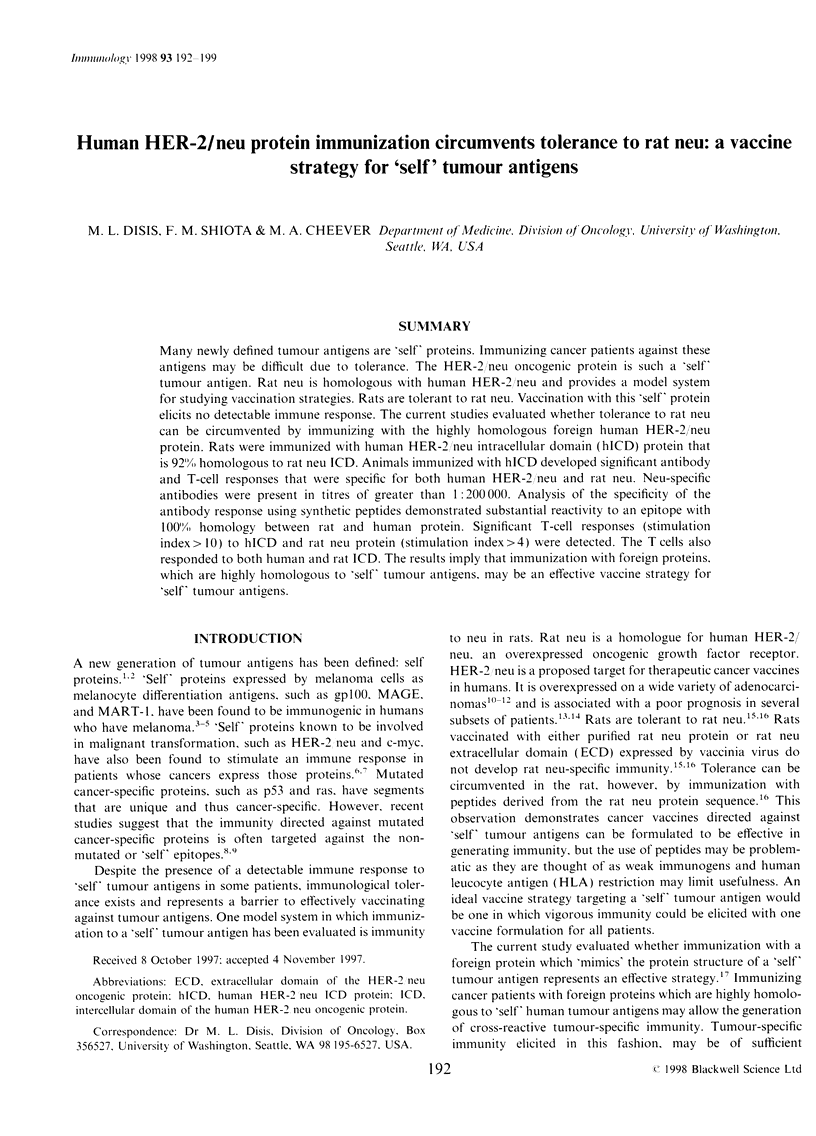
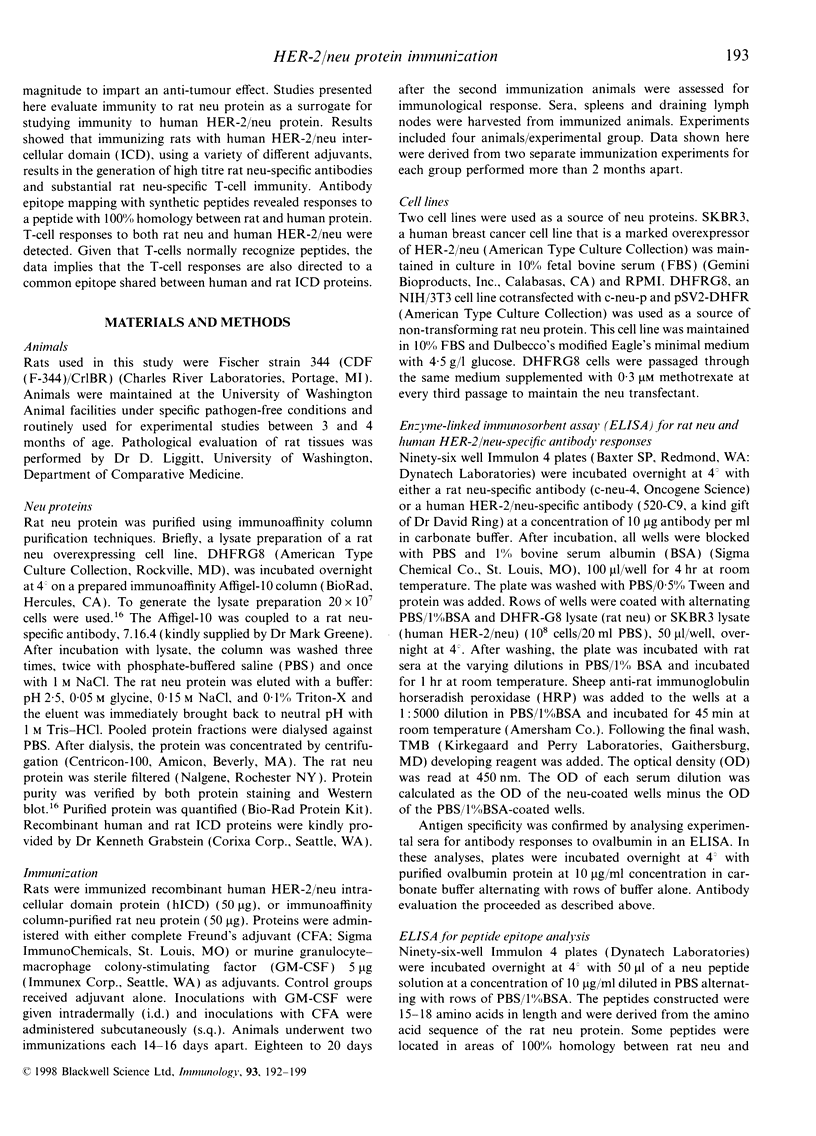
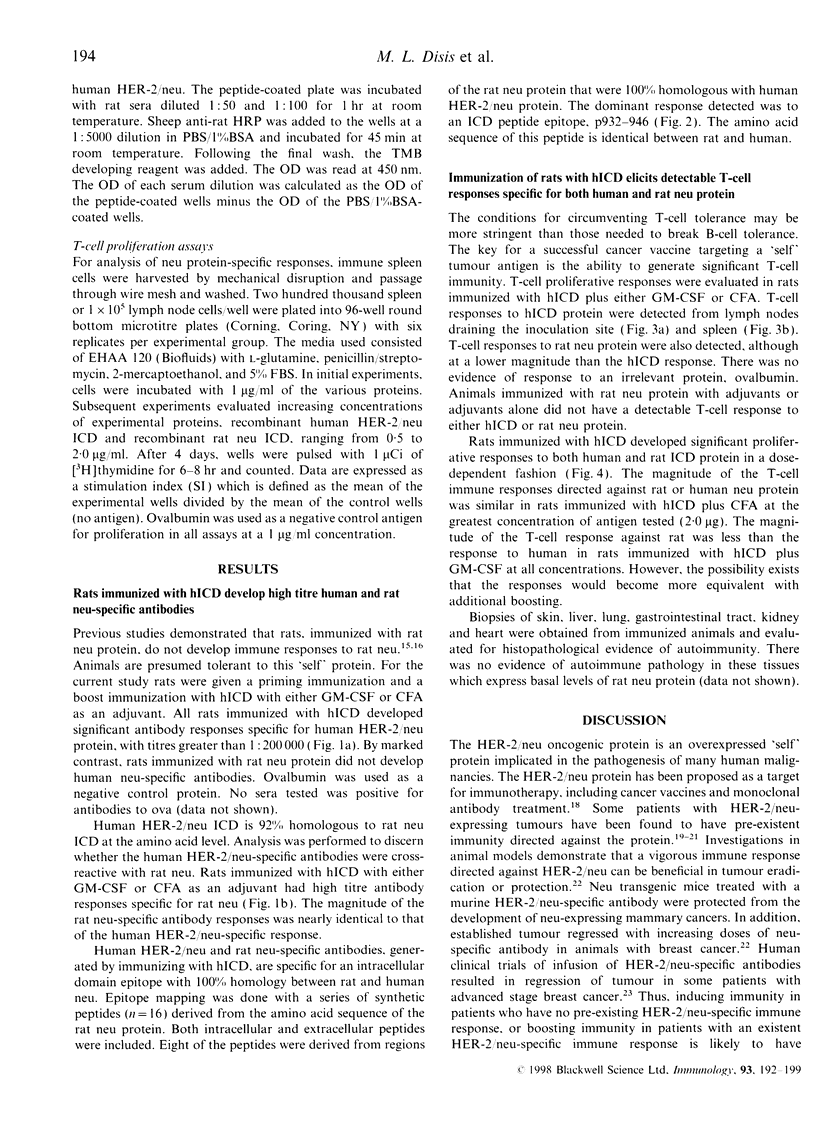
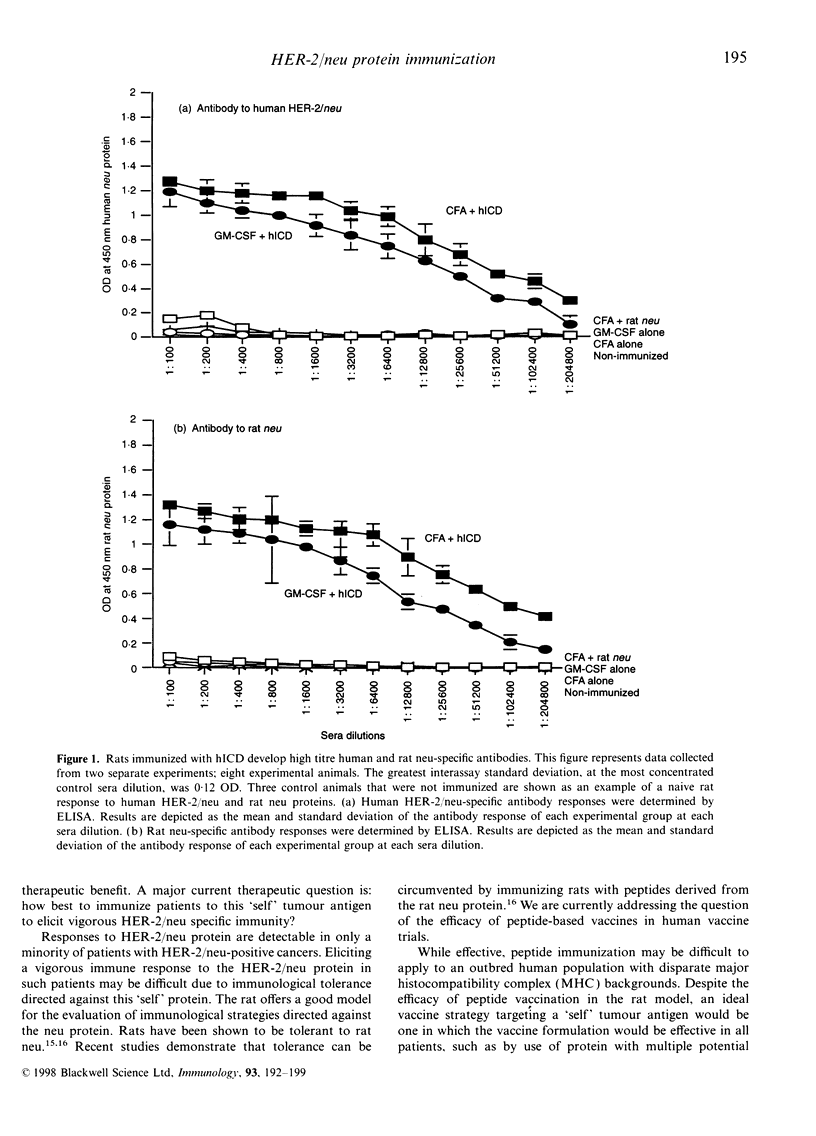
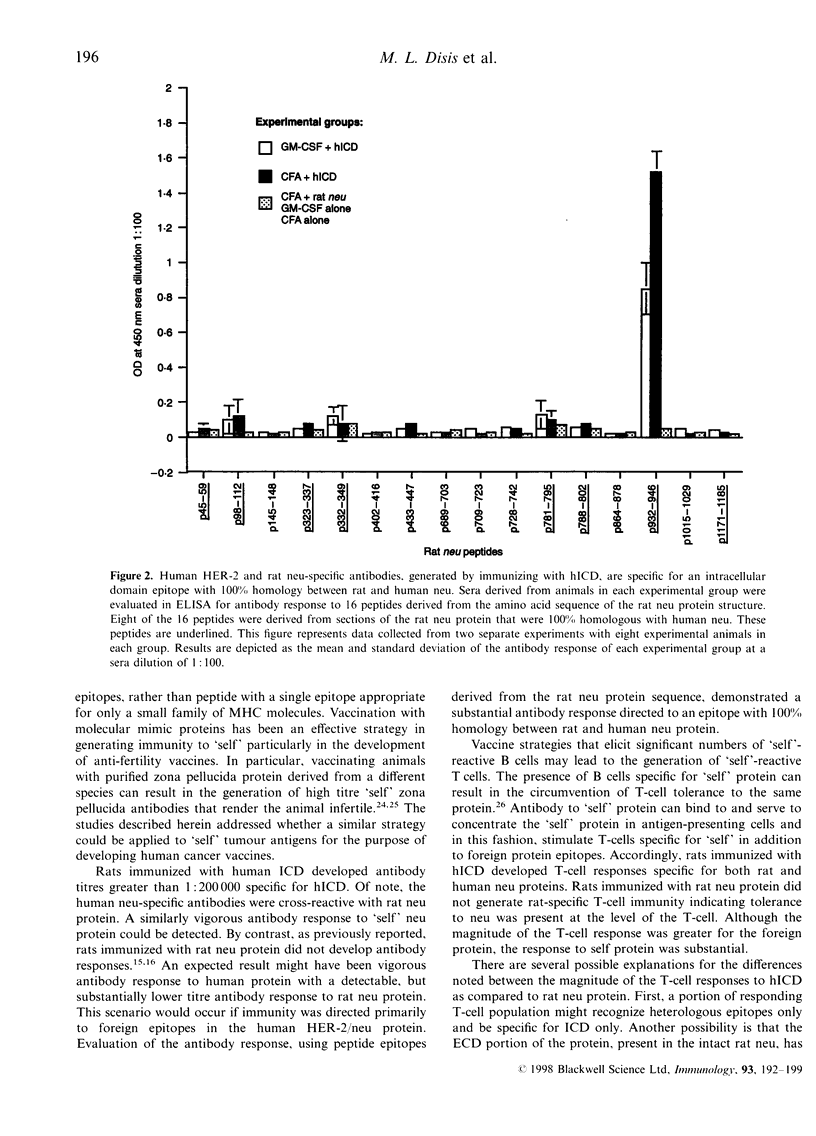
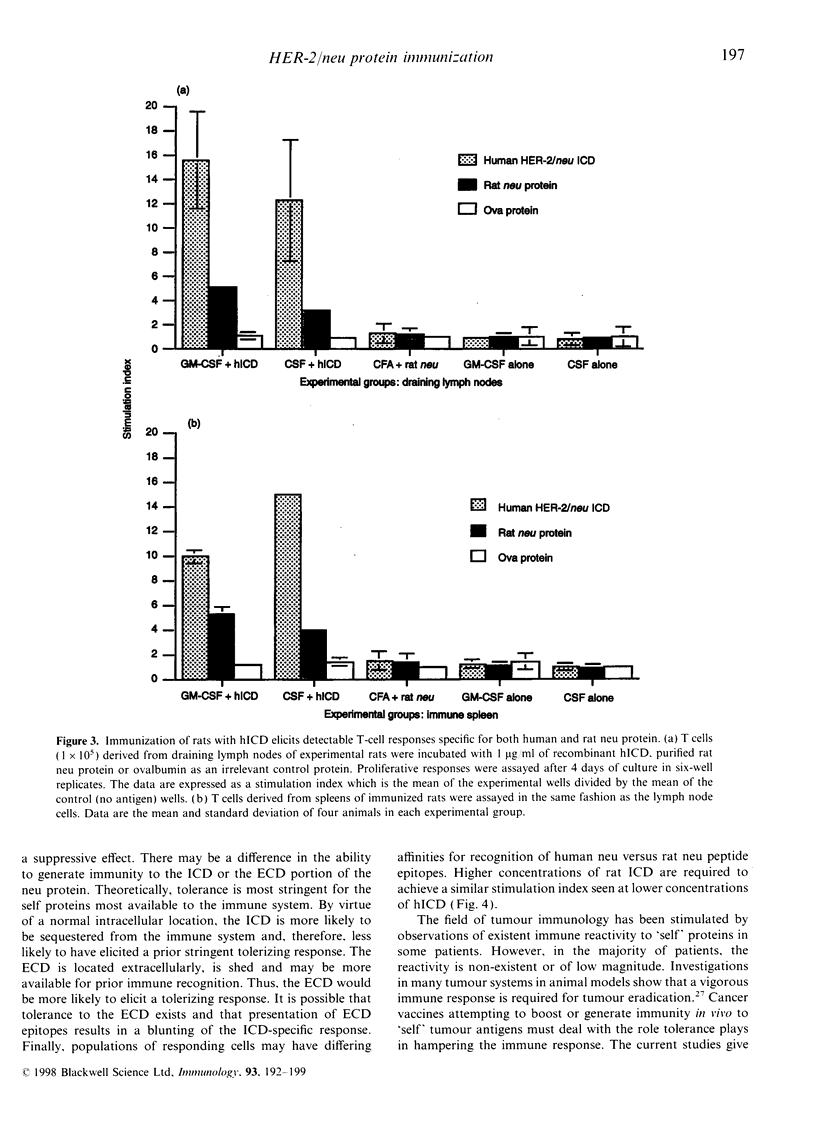
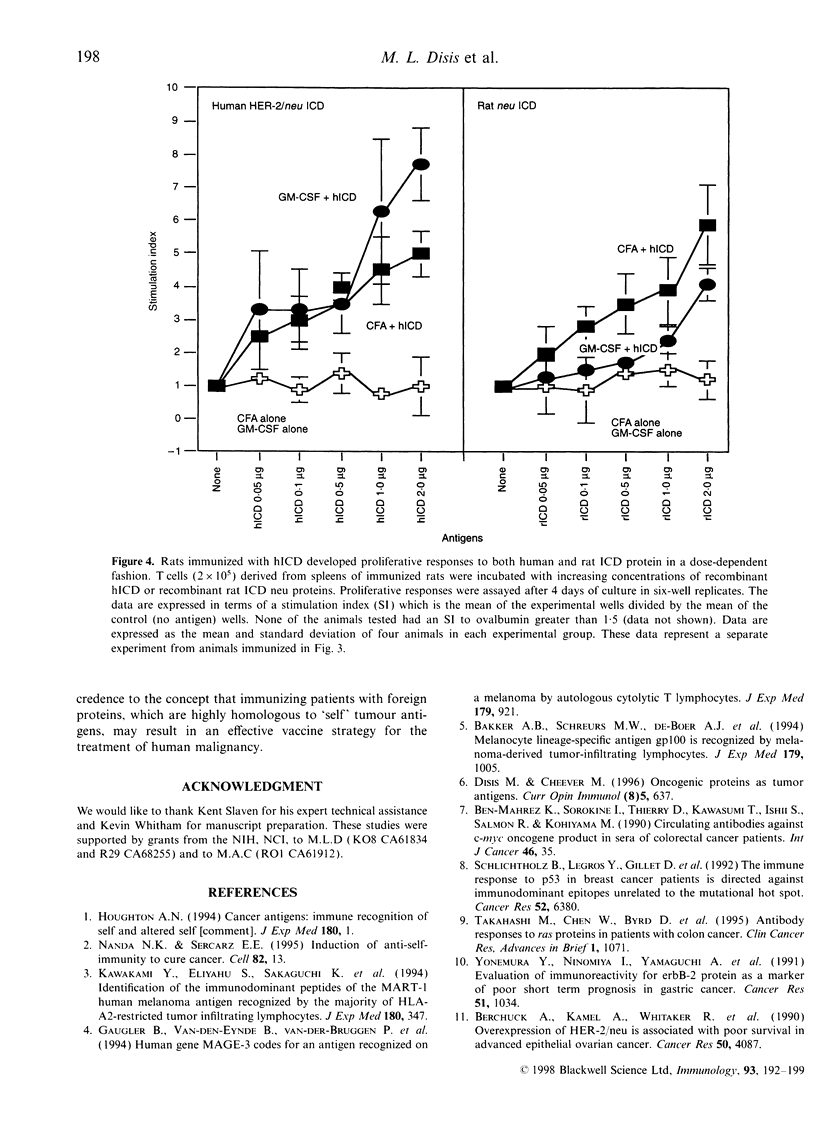
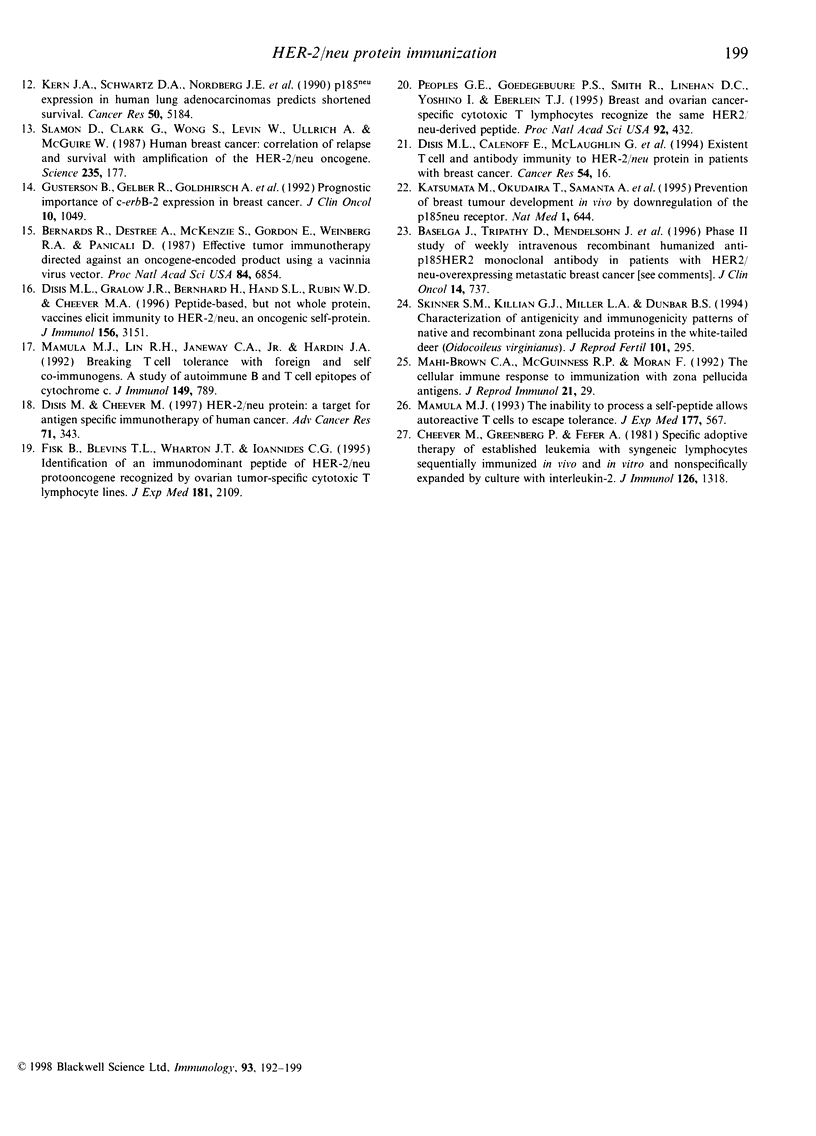
Images in this article
Selected References
These references are in PubMed. This may not be the complete list of references from this article.
- Bakker A. B., Schreurs M. W., de Boer A. J., Kawakami Y., Rosenberg S. A., Adema G. J., Figdor C. G. Melanocyte lineage-specific antigen gp100 is recognized by melanoma-derived tumor-infiltrating lymphocytes. J Exp Med. 1994 Mar 1;179(3):1005–1009. doi: 10.1084/jem.179.3.1005. [DOI] [PMC free article] [PubMed] [Google Scholar]
- Baselga J., Tripathy D., Mendelsohn J., Baughman S., Benz C. C., Dantis L., Sklarin N. T., Seidman A. D., Hudis C. A., Moore J. Phase II study of weekly intravenous recombinant humanized anti-p185HER2 monoclonal antibody in patients with HER2/neu-overexpressing metastatic breast cancer. J Clin Oncol. 1996 Mar;14(3):737–744. doi: 10.1200/JCO.1996.14.3.737. [DOI] [PubMed] [Google Scholar]
- Ben-Mahrez K., Sorokine I., Thierry D., Kawasumi T., Ishii S., Salmon R., Kohiyama M. Circulating antibodies against c-myc oncogene product in sera of colorectal cancer patients. Int J Cancer. 1990 Jul 15;46(1):35–38. doi: 10.1002/ijc.2910460109. [DOI] [PubMed] [Google Scholar]
- Berchuck A., Kamel A., Whitaker R., Kerns B., Olt G., Kinney R., Soper J. T., Dodge R., Clarke-Pearson D. L., Marks P. Overexpression of HER-2/neu is associated with poor survival in advanced epithelial ovarian cancer. Cancer Res. 1990 Jul 1;50(13):4087–4091. [PubMed] [Google Scholar]
- Bernards R., Destree A., McKenzie S., Gordon E., Weinberg R. A., Panicali D. Effective tumor immunotherapy directed against an oncogene-encoded product using a vaccinia virus vector. Proc Natl Acad Sci U S A. 1987 Oct;84(19):6854–6858. doi: 10.1073/pnas.84.19.6854. [DOI] [PMC free article] [PubMed] [Google Scholar]
- Cheever M. A., Greenberg P. D., Fefer A. Specific adoptive therapy of established leukemia with syngeneic lymphocytes sequentially immunized in vivo and in vitro and nonspecifically expanded by culture with Interleukin 2. J Immunol. 1981 Apr;126(4):1318–1322. [PubMed] [Google Scholar]
- Disis M. L., Cheever M. A. HER-2/neu protein: a target for antigen-specific immunotherapy of human cancer. Adv Cancer Res. 1997;71:343–371. doi: 10.1016/s0065-230x(08)60103-7. [DOI] [PubMed] [Google Scholar]
- Disis M. L., Cheever M. A. Oncogenic proteins as tumor antigens. Curr Opin Immunol. 1996 Oct;8(5):637–642. doi: 10.1016/s0952-7915(96)80079-3. [DOI] [PubMed] [Google Scholar]
- Disis M. L., Gralow J. R., Bernhard H., Hand S. L., Rubin W. D., Cheever M. A. Peptide-based, but not whole protein, vaccines elicit immunity to HER-2/neu, oncogenic self-protein. J Immunol. 1996 May 1;156(9):3151–3158. [PubMed] [Google Scholar]
- Fisk B., Blevins T. L., Wharton J. T., Ioannides C. G. Identification of an immunodominant peptide of HER-2/neu protooncogene recognized by ovarian tumor-specific cytotoxic T lymphocyte lines. J Exp Med. 1995 Jun 1;181(6):2109–2117. doi: 10.1084/jem.181.6.2109. [DOI] [PMC free article] [PubMed] [Google Scholar]
- Gaugler B., Van den Eynde B., van der Bruggen P., Romero P., Gaforio J. J., De Plaen E., Lethé B., Brasseur F., Boon T. Human gene MAGE-3 codes for an antigen recognized on a melanoma by autologous cytolytic T lymphocytes. J Exp Med. 1994 Mar 1;179(3):921–930. doi: 10.1084/jem.179.3.921. [DOI] [PMC free article] [PubMed] [Google Scholar]
- Gusterson B. A., Gelber R. D., Goldhirsch A., Price K. N., Säve-Söderborgh J., Anbazhagan R., Styles J., Rudenstam C. M., Golouh R., Reed R. Prognostic importance of c-erbB-2 expression in breast cancer. International (Ludwig) Breast Cancer Study Group. J Clin Oncol. 1992 Jul;10(7):1049–1056. doi: 10.1200/JCO.1992.10.7.1049. [DOI] [PubMed] [Google Scholar]
- Houghton A. N. Cancer antigens: immune recognition of self and altered self. J Exp Med. 1994 Jul 1;180(1):1–4. doi: 10.1084/jem.180.1.1. [DOI] [PMC free article] [PubMed] [Google Scholar]
- Katsumata M., Okudaira T., Samanta A., Clark D. P., Drebin J. A., Jolicoeur P., Greene M. I. Prevention of breast tumour development in vivo by downregulation of the p185neu receptor. Nat Med. 1995 Jul;1(7):644–648. doi: 10.1038/nm0795-644. [DOI] [PubMed] [Google Scholar]
- Kawakami Y., Eliyahu S., Sakaguchi K., Robbins P. F., Rivoltini L., Yannelli J. R., Appella E., Rosenberg S. A. Identification of the immunodominant peptides of the MART-1 human melanoma antigen recognized by the majority of HLA-A2-restricted tumor infiltrating lymphocytes. J Exp Med. 1994 Jul 1;180(1):347–352. doi: 10.1084/jem.180.1.347. [DOI] [PMC free article] [PubMed] [Google Scholar]
- Kern J. A., Schwartz D. A., Nordberg J. E., Weiner D. B., Greene M. I., Torney L., Robinson R. A. p185neu expression in human lung adenocarcinomas predicts shortened survival. Cancer Res. 1990 Aug 15;50(16):5184–5187. [PubMed] [Google Scholar]
- Mamula M. J., Lin R. H., Janeway C. A., Jr, Hardin J. A. Breaking T cell tolerance with foreign and self co-immunogens. A study of autoimmune B and T cell epitopes of cytochrome c. J Immunol. 1992 Aug 1;149(3):789–795. [PubMed] [Google Scholar]
- Mamula M. J. The inability to process a self-peptide allows autoreactive T cells to escape tolerance. J Exp Med. 1993 Feb 1;177(2):567–571. doi: 10.1084/jem.177.2.567. [DOI] [PMC free article] [PubMed] [Google Scholar]
- Nanda N. K., Sercarz E. E. Induction of anti-self-immunity to cure cancer. Cell. 1995 Jul 14;82(1):13–17. doi: 10.1016/0092-8674(95)90047-0. [DOI] [PubMed] [Google Scholar]
- Peoples G. E., Goedegebuure P. S., Smith R., Linehan D. C., Yoshino I., Eberlein T. J. Breast and ovarian cancer-specific cytotoxic T lymphocytes recognize the same HER2/neu-derived peptide. Proc Natl Acad Sci U S A. 1995 Jan 17;92(2):432–436. doi: 10.1073/pnas.92.2.432. [DOI] [PMC free article] [PubMed] [Google Scholar]
- Schlichtholz B., Legros Y., Gillet D., Gaillard C., Marty M., Lane D., Calvo F., Soussi T. The immune response to p53 in breast cancer patients is directed against immunodominant epitopes unrelated to the mutational hot spot. Cancer Res. 1992 Nov 15;52(22):6380–6384. [PubMed] [Google Scholar]
- Skinner S. M., Killian G. J., Miller L. A., Dunbar B. S. Characterization of antigenicity and immunogenicity patterns of native and recombinant zona pellucida proteins in the white-tailed deer (Oidocoileus virginianus). J Reprod Fertil. 1994 Jul;101(2):295–303. doi: 10.1530/jrf.0.1010295. [DOI] [PubMed] [Google Scholar]
- Slamon D. J., Clark G. M., Wong S. G., Levin W. J., Ullrich A., McGuire W. L. Human breast cancer: correlation of relapse and survival with amplification of the HER-2/neu oncogene. Science. 1987 Jan 9;235(4785):177–182. doi: 10.1126/science.3798106. [DOI] [PubMed] [Google Scholar]
- Takahashi M., Chen W., Byrd D. R., Disis M. L., Huseby E. S., Qin H., McCahill L., Nelson H., Shimada H., Okuno K. Antibody to ras proteins in patients with colon cancer. Clin Cancer Res. 1995 Oct;1(10):1071–1077. [PubMed] [Google Scholar]
- Yonemura Y., Ninomiya I., Yamaguchi A., Fushida S., Kimura H., Ohoyama S., Miyazaki I., Endou Y., Tanaka M., Sasaki T. Evaluation of immunoreactivity for erbB-2 protein as a marker of poor short term prognosis in gastric cancer. Cancer Res. 1991 Feb 1;51(3):1034–1038. [PubMed] [Google Scholar]




